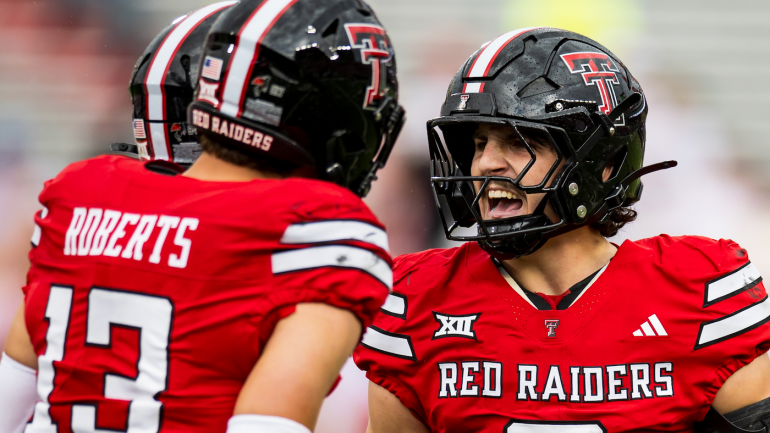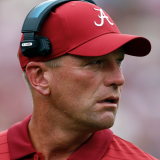
Texas Tech's portal spending spree well worth the investment as transfer additions complete defensive overhaul
The Red Raiders' unbeaten start is thanks in part to a new-look defense almost a year in the making

After catching a movie during a recent team-building exercise, Joey McGuire pulled back his seat on Texas Tech's team bus to listen in on a conversation behind him.
It was heavy on Xs and Os, sparking McGuire's interest on his return to campus. Senior Jacob Rodriguez was the first to reveal what had him grinning ear to ear with fellow linebacker Ben Roberts.
"He was like, 'Coach, you don't understand, because of Lee Hunter, we can go make a play that's not necessarily in our gap because he's taking up two (blockers),'" McGuire told CBS Sports this month.
This newfound luxury for Rodriguez and Roberts, Texas Tech's top returning tacklers from last season's eight-win team, means greater flexibility for big plays as leaders on a defense ranked No. 1 nationally against the run and slotted inside the top 10 across multiple other categories including sacks, fewest total yards allowed, scoring and takeaways.
An impactful, 6-foot-4, 330-pound nose like Hunter was a necessity this offseason and a hot commodity in the transfer portal for a program seeking more girth and power at the line scrimmage. Hunter, who signed with Auburn before spending the last three years at UCF, was one of 10 new defensive additions as part of a 21-player group.
This is exactly what McGuire envisioned when his unbeaten and seventh-ranked Red Raiders went all-in this offseason with roster retention and additions.
"As a whole, this defense just plays so freaking hard, man," McGuire said. "One thing we talk about all the time is go take your shot. We're going to mess up, we're going to make mistakes. But you've got 10 brothers on that field with you that will be screaming to the football. I think our guys are playing with a level of confidence in (one another)."
Texas Tech's 2025 transfer class was rated as the second-best haul nationally by 247Sports -- a calculated and high-cost bet that's paying off for the Big 12 frontrunners. And if this level of heightened progress continues, this unit -- defined by a mix of returning veterans and portal stars -- could go down as the best in program history.

No team was better than Texas Tech this season in defensive stop rate entering last week's 42-17 win over Kansas. The Red Raiders were one of only four teams nationally giving up less than 1 point per drive this season. Stop rate is self-explanatory -- the percentage of a team's defensive possessions that end in punts, takeaways or a turnover on downs.
Against the Jayhawks, that statistical superlative was challenged after Kansas scored 17 points in the second quarter. Texas Tech responded with a shutout after intermission, holding Jalon Daniels and a talented offense to 120 total yards on 38 plays, and finished with a team-record nine sacks.
"We had trouble blocking them all second half, especially," Kansas coach Lance Leipold said. "That's a really good defensive front. I think it showed up, no doubt."
David Bailey, a spring addition for the Red Raiders from Stanford, leads college football with 8.5 sacks and 9.5 tackles for loss and anchors that dominant front from left to right with Hunter, Skyler Gill-Howard and Romello Height at the other edge spot, among others.
Rodriguez has a team-best 50 tackles through six games, while Mississippi State transfer Brice Pollock is tied for the conference lead with three interceptions.
"Coach (Shiel) Wood and Coach (Jack) Teachey have those guys playing to a standard when they step on the field," McGuire said. "(It) starts with Jacob holding everybody to that standard and they follow his lead."
Red Raiders' transfer impact on defense
Player | Production | Former school |
David Bailey, Edge | 8.5 sacks, 9.5 TFL | Stanford |
Romello Height, Edge | 4.5 sacks, 4.5 TFL | |
Lee Hunter, DL | 15 tackles, 1.5 TFL | UCF |
Skyler Gill-Howard, DL | 13 tackles, 2.5 TFL | |
Brice Pollock, CB | 21 tackles, 3 INT | Mississippi State |
28 tackles, sack, 2 TFL | ||
AJ Holmes Jr., DL | 3 sacks, 4.5 TFL |
There's more depth in the secondary, too. After finishing at the bottom of the Big 12 last season in pass defense allowing 308.1 yards per game, Texas Tech secured signatures from five new players at the back end to solidify the plan.
Pollock, Cole Wisniewski, Tarrion Grant, Amier Boyd and Dontae Balfour have made their presence felt in a big way collectively, helping the Red Raiders move up to sixth-best in the conference in pass defense this season at 194.3 yards allowed per game through the air.
Should that number hold, that would be one of the best marks in school history.
Texas Tech's recruiting plan
Immediate ROI was the expectation for the Red Raiders this season after former player and Texas billionaire Cody Campbell was instrumental in putting the plan together to help fund this star-studded two-deep. His influence is well-documented, but it was up to McGuire, his assistants and Texas Tech's personnel staff to figure out the pieces that fit and do so in a timely manner.
"It started with retaining the guys we had we felt were really good, keeping those guys and then going to get difference-makers up front," McGuire said of Texas Tech's recruiting plan. "If you're really going to go all in and you're wanting to challenge for the Big 12 and playoff, then the guys you're going to be playing against there are going to be really good.
"Texas has been extremely good on the offensive and defensive lines. Alabama, Georgia, Ohio State for years and years. All those draft picks the last (few) years are all coming out of those rooms. It was a big emphasis for us, going to get those guys."
Guess who's ranked higher than those three elite programs against the run this season? Texas Tech allows 62.5 rushing yards per game, 10 yards fewer than college football's second-best in the trenches (Missouri). And only Ohio State has allowed fewer rushing touchdowns (1) at midseason than the Red Raiders (2).
Determining program fit from a collection of portal talent is the hardest part of the recruiting process and McGuire said the Red Raiders utilized every information outlet available to them to ensure every transfer would help the program.
"Once we liked an athlete, we tried to connect with as many people as we could," McGuire said. "Mack Brown's a really good friend of mine, so when (offensive tackle) Howard Sampson got in the portal, I was able to call him. He was a big part in us landing Howard. We actually face-timed Mack on his visit. That was the key. Once you identify a player as scheme fit with the right athletic traits, you go from there."
Playoff or bust moving forward
McGuire doesn't gloss over expectations for his football team and knows everyone in his building and those associated with Texas Tech football expect to get to the playoff this season.
One of three Big 12 teams with an unblemished conference record thus far, the Red Raiders travel to Arizona State this weekend before finishing with five games against league competition, including nationally-ranked BYU in Lubbock on Nov. 8.
Only one game separates first place in the Big 12 from a tie for seventh, so the margin for error is slim moving forward in the race to get to AT&T Stadium in Arlington for the league championship game on Dec. 6. Ironically, Texas Tech is currently projected to be the No. 4 seed in the playoff if it wins the Big 12, which could result in a second game at the Dallas Cowboys' home venue -- and a first-round bye -- in the postseason.
However, there's much to be decided before making plans for that scenario according to McGuire. For now, Texas Tech will refine its week-by-week approach with the mindset of pummeling the competition into submission at the line of scrimmage, a far cry from the pass-heavy, sexy Air Raid that had become synonymous with Texas Tech.


















